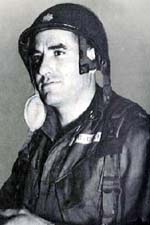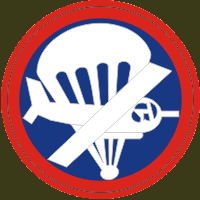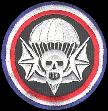|
|
.
502ND PIR . Parachute
Infantry Regiment |
|
![]() Roster
Roster
Although the airborne attack on Crete on May 20, 1941 rang the knell for the German airborne operations, the American planners had no knowledge of the important casualties which were suffered by German paratroopers
Instead of this, they focused on strategic and tactical success of the operation, underlining the fact that Crete was invaded by Airborne troops only, without any other support
As a result, the American Army accelerated the organization of the new airborne units.
It is on July 1, 1941 that the 502nd parachutist battalion was created at Fort Benning, based on small detachment from the 501st PIR and under the command of Major George P. Howell Jr. who is also, as a matter of fact an ex-commander of the 501st PIR. The year of its creation this unit will start building its history by taking part in two airdrop exercises in the sky of Carolina.
After December 7, 1941 “the infamous day”, the formation and the development of the airborne forces were encouraged. On January 30, 1942, the department of war created with haste 4 regiments of parachutists infantry . A month later, on March 2, 1942, the 502nd regiment of parachutist (PIR) is created at Fort Benning. Howell is promoted Colonel and takes the head of the parachutist school of Fort Bragg. After this promotion the command of the regiment goes to Colonel George Van Horn Moseley Jr. who comes from West Point.
 <-Colonel George Van Horn Moseley
Jr.
<-Colonel George Van Horn Moseley
Jr.
In July 1942, two airborne divisions are created,the famous 82nd and 101st. The 502nd becomes a permanent unit of the 101st and leaves Fort Benning to join the rest of the division with at Fort Bragg.
During all the year 1942-43, the 502nd endured a very physical formation which breaks up into different formation groups, of the soldier, the unit and division.
In March 1943, the regiment takes part in operations with the division in Southern Pines, soon followed by operations in Camden started on May 23 of the same year.
And finally, of army maneuvers in Tennessee.
On September 4, the 502nd embarcs on S.S.Strathnaver in direction of England.
After sailing for 6 days the S,S Strathnaver is deviated to the port of St Johns Newfoundland, on September 11 to be repaired.
But other problems are soon discovered on the ship and the 502nd unit is forced to board on the S.S John Ericsson and will only arrive at Liverpool on October 18th.
They were stationed in the area of Chilton Foliat and Denford close to Hungerford in Berkshire for 7 months. There, they continued their intensive training in a new scenery made of small villages with houses in thatched roofs. The training was also supplement by other exercices : map reading, chemical war, use of German weapons.
During the winter, a modification was made to the regiment, Captain Lillyman , commander of Company I, took command of the Pathfinders of the 101st, he was replaced by Captain Ivan Hershner until June 9, 1944. 502nd also received its identifying code (Kickoff) which they kept all along the war.
During the training period in England, the regiment took part in several great maneuvers, including fakes attack on assigned objectives. In March it was the operation BEAVER, in April, TIGER and in May, EAGLE. Each time the objective was the same : attack enemy positions and secure bridges. But, during the exercise EAGLE things went a little wrong. Indeed, 8 of the 9 planes transporting the men of the H Company released their men 15km away from their initial drop zone. They did not know it, but it was a sign of what it will occur 1 month later.
After months of training the 502rd was sent in camps in the south of England. Once there, they were cut off the rest of the world for safety measures. They received their equipment and waited for orders.
The objective of the 502nd was for the 3rd battalion to take and hold exits 3 (Audoville la Hubert) and 4 (St Martin de Varreville) in the north of Utah whereas the 1st and 2nd Battalion, had to destroy German heavy gun positions (122mm)placed in 4 bunkers nearby exit 4 (St Martin-of-Varreville) to prevent there use against troops landing on the beach. They will be reinforced by 377th PFAB.
![]() D-DAY – June 44 – Normandy – France – Operation Neptune
D-DAY – June 44 – Normandy – France – Operation Neptune
Taking off from the Membury and Greenham airfields, the 502nd was heading towards its landing zone : DZ A close to Saint-Martin-de-Varreville where a German coastal gun position of 122mm is placed.
But soon problems occurred. While flying toward Normandy, clouds and Germand DCA broke the C-47 formation transporting troops.
The formation became such a big mess, that some of the paras were dropped over the channel, and had no chance to survive with equipment which was so heavy . The 1st and 3rd battalion mainly landed near DZ A whereas 2nd battalion landed nearly exclusively on the DZ C. Two sticks of company A received the signal to jump too late, and landed in the canal, causing important casualties, most of them drowning because of their equipment, in particular the company commander , Captain Richard L Davidson. Certain sticks (parachutists groups transported in C-47) have landed with more than 8 kilometers away from their objective.
Unfortunately, while landing, Colonel Moseleys leg broke. As a result he gave his command to his assistant, Colonel John H. Michaelis.
 <-Colonel John H. Michaelis
<-Colonel John H. Michaelis
During this time, the 3rd battalion commanded by Lieutenant colonel Robert G. Stick had the objective of occupying two roadways. With dexterity,he gathered his men and took his objective.
Once replace by the troops who landed on the beaches, the men were gathered and sent to attack a hill, carrying the name of Hill 30 close to La Billionnerie to block the German retreat of Carentan. To arrive there, they had to pass by a road surrounded on each side by the marsh. This roadway took the name of Purple Heart Lane because of the important casualties that the regiment will suffer. And as if that wasn't hard enough, this roadway went through 4 bridges including one, the bridge number 2, which was destroyed.
On June 10, men of the Company G under the orders of First Lieutenant Robert Captain and of Lieutenant David Irwin attacked, followed by company H and I. The following days, the two sides of the road and the German defensive positions in the marshes were clear.
However on June 11, the men still had trouble on the roadway, so as a result the lieutenant colonel Robert G. Stick ordering the 3ème battalion gave order to his men to fix their bayonets. Then, he took the head of the attacked only equiped with a Colt. They attacked a farm held the Germans. (the farm Ingouf) This farm is located at a strategic place for the passage of the 4ème bridge, it is indeed on the right-hand side of this one. It is for this operation that lieutenant colonel Robert G. Stick received the medal of honor of the Congress. Unfortunately, it will never carry it, he will be killed by a sniper in Holland.
 <-Lieutenant Colonel Robert G. Cole
<-Lieutenant Colonel Robert G. Cole
A few days later, the Germans counter-attacked on the left of the farm. They were stopped by the men of the 1st battalion. On June 13, the men of the 2nd battalion joined the 506th PIR to attack in the South-west of Carentan. It was the last fight of 502nd PIR.
On June 29, 101st is replaced by VIII Corp. The Division is sent to Cherbourg to replace the 4th Division of infantry. A little later, the 502nd, is sent back to England to rest and reform the unit.
In England, during the two next months, 502nd got new men and started to train themselves again to prepare the next operation. Several times the unit was ready to land in France but each time, the operation were canceled.
In August 1944, Eisenhower creates the first Allied Airborne Army (AAA) division made up of American, British and also, Polish.
At the same time, the 17th, 82nd and 101st airborne were made into one, the XVIII airborne Corp newly created and under the orders of General Matthew Ridgway.
This new Corp will have its first war experience in Holland, September 1944.

Holland – september 1944 – operation Market-Garden
This audacious plan conceived by British Field Marshall Montgomery would be the first airborne day operation .
Like the German attack on Crete, this operation ,who happened on September 17, 1944 was only based on airborne infantry in gliders. The 82nd and 101st with the English and Polish airborne forces had to land in daylight.
The airborne troops had to secure the roads, the bridges and the principal towns like Eindhoven, Nimègue and Arnhem and thus to cut Holland in two and to build a corridor for the British armoured divisions to move towards the German border as fast as possible.
The objective assigned to the 101st was to control a road long of 16Km(to call road of the hell) stretching from North of Eindhoven to Veghel.
After less than three months in England, the 502nd, always under the command of Michaelis, was leaving on mission again. Their objective was to land on DZ C and take a bridge above the river Dommel close to St Oedenrode and the railroad bridge and roads of the small city of Best.
It also had the role of keeping the DZ B and C for the gliders to land,
Their jump took palce on September 17, 1944 at 13h15. The 1st battalion took off from Wellford on 45 C-47 : direction DZ B. The rest of the regiment took off from Greenham on 90 C-47 : direction DZ B also. After an perfect landing, the men moved towards their objectives. The first battalion moved towards north to take the small city of St Oedenrode. The third battalion was sent by the forest of Zonsche to the small city of Best to take the bridges. German resistance was important in front of Best. 502nd approached in less then 100 meters from the bridge, when the Germans destroyed it.
Around the bridge ruins, fighting was of a rare intensity !
A heroic act, one in many others, is to attribute to Private Joe Mann who had already been wounded twice during the fighting, saved his comrades by throwing himself on a grenade which had landed in their fighting holes. For this act of bravery, Joe Mann accepted the medal of honor on a purely posthumous basis.
Unhappy coincidence, the second to be accepted to this distinction, is Colonel Robert Sticks, found dead close to the forest of Zonsche, killed by a sniper.
The third battalion passed under the orders of Major John Stopka.
September 22, Lieutenant Colonel Michaelis and three members of his team are seriously wounded by an artillery shell fallen on the HQ.
The command passes then to the second commander of the second battalion, Steve Chappuis.
 <-Lieutenant Colonel Steve Chappuis
<-Lieutenant Colonel Steve Chappuis
But hard fighting was to come in the forest of Zonsche. However 502nd finally, received the reinforcement of the tanks of the 30th British Corp. The regiment, without the 1st battalion, destroyed and captured German troops.
After catching their objective , 502nd followed 101st who moved in the sector of “ the Island ” in the south-west of Arnhem. 502nd stayed in backup, close to the city of Dodewaard. The actions were limited to patrols to locate the enemy infiltrations. During these actions, paras of 502nd were especially victim of the German mines. Finally, in December 502nd and the 101st, were withdrawn from fighting zone and were sent in an old garrison located at Rheims in France, called Mourmelon camp. During this time, men rested, the training was limited to gymnastics. Red Cross assured some theater show to divert the men. But this period will remain short.
On December 16, 1944, Germans launch a great offensive in the Bulge Forest, heading for American defenses ensured by VII Corp.
The objective was re-occupy Antwerp, the only major harbor close to the fighting zone were huge amounts of food were disembarked.
101st was quickly dispatched towards the city of Bastogne, strategic city, were crossroads of several important roads met up.
On the night of December 18th troops were led to Bastogne in a long ands tiring trip.
As soon as they arrived, the men of 101st made obstacle to the offensive of 5th Panzer of Hasso von Manteuffel.
But in the following days, Bastogne was surrounded.
502nd held positions in the North and the North-West of Bastogne. And, Germans who weren't managing to break American defenses sent patrols .
In the sector held by 502nd, the attack occurred the morning after Christmas, in the area of Hemroulle. Many panzers penetrated the lines.
At the same time, more in the North, infantry units infiltrated defenses of the city of Champs.
Two enemy panzers moved towards the HQ of 502nd located at Chateau de Rolle. However, without taking accoumpt of danger, soldier Sky Jackson gained his Silver Star by destroying them with only a Bazooka.
Others panzers wanting to escape from Champs were destroyed by John Ballard, who is a member of company A. Unfortunately he will be killed on January 3, 1945.
To finish, on December 26 tanks belonging to 4th division from III army of Patton broke surrounding.
January 3, the 2nd battalion was engaged in hard fighting around the city of Longchamps. The Germans made 40 prisoners coming from F company .
On January 14, the 3rd battalion lost again his commander. Lieutenant Colonel John Stopka and some of its men advanced in a pine forest following a railway. In the meantime German Panzers were advancing on the other side. An American soldier ask for air support. Unfortunately the planes hedgehopped to close too the American group having as result, death of 30 soldiers including John Stopka.
The Command of 3rd battalion was given to Cécil L. Simmons till the end of the war. Little time after, the objective, the town of Bourcy, in Belgium, was taken.
At the same time, 101st airborne held a line of defence along the river Moder during more than one month as an element of 7th US army.
On February 23, 1945, they were sent back to rest in Mourmelon, France.
General Eisenhower visited them and gave, to all of the division, Distinguished Unit Quotation for their bravery in Bastogne.
 The End – 1945
The End – 1945
The end of war approaching, the 502nd was sent in The Ruhr region on April 2, and once there, they had to hold a line facing The Rhine in the south of Düsseldorf.
On May 4, the last mission of 502nd was to occupy Berchtesgaden, Hitler's “Eagle nest”
502nd passed the summer 1945 in Austria close to Mittersill. In September, the unit came back in France in the area of Joigny-Auxerre.
On November 30th, the 502nd PIR was inactivated .
United States :
2 Presidential Unit Citations for the operations in Normandy and Bastogne
France :
French Croix de Guerre with palm for the operation in Normandy
Belgique :
2 Belgian Croix de Guerre with Palm and Belgian Fourragere for the operations in Bastogne
Netherlands :
Netherlands Orange Lanyard for operations in Netherlands

